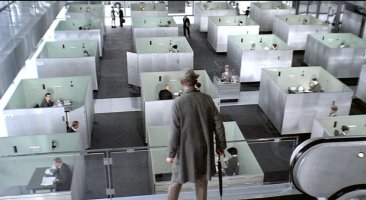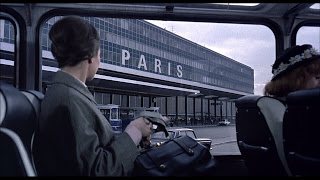How To Watch A 70mm Masterpiece: Getting Ready For Playtime
By Steven Pate in Arts & Entertainment on Feb 19, 2013 7:00PM
 Because movies are so readily available to rent, own or stream in video format, we have gotten used to thinking of them as entertainment commodities, items we can consume any time we get the notion. This is not always the case. Case in point, one of the treasures of the Music Box's 70mm fest this week, Jacques Tati's masterpiece, Playtime, a film you really have to see on the big screen. Here's a movie with almost no plot, but where so much happens that you can't take it all in. How can you get the most out of your journey to Tativille? We've got you covered.
Because movies are so readily available to rent, own or stream in video format, we have gotten used to thinking of them as entertainment commodities, items we can consume any time we get the notion. This is not always the case. Case in point, one of the treasures of the Music Box's 70mm fest this week, Jacques Tati's masterpiece, Playtime, a film you really have to see on the big screen. Here's a movie with almost no plot, but where so much happens that you can't take it all in. How can you get the most out of your journey to Tativille? We've got you covered.
Let Hulot be your guide
Watch out for the guy in the overcoat and hat, whose pants legs are short enough to show off some natty socks, and who will always be carrying an umbrella and often be smoking a pipe. That's Mr. Hulot, the beloved centerpiece of Tati's two previous films, Mr. Hulot's holiday and Mon Oncle, which brought him international fame (including an Oscar for best foreign film). He doesn't say much, but Hulot is friendly and well-meaning, tending to find himself at odds with modern technologies and conveniences. Keep your guard up, though, because Tati plants lookalikes strategically throughout the movie, so the Hulot you think you're watching may turn out to be a "false Hulot," and often finding him in the vastness of Tati's frame can be like a game of "Where's Waldo?" So don't worry if there's no Hulot to find, or if you think you've missed him. Miscues and misdirection is par for the course. Just be like Hulot, and carry on.
Allow yourself to be a tourist
Where Hulot had been the centerpiece of the earlier films, in Playtime he becomes one thread in a vast tapestry. Tati said "there were no stars in the film, or rather, the set was the star," and what a star it is. Tati constructed a vast landscape of glass and metal exhaustively appointed with the minimalist, mid-century modern coolness of a 1960s idea of the city of the future. Keep in mind that literally everything you see in this movie (from the airport and trade expo to the office buildings and streets, apartments) was built. This is said to have involved "11,700 square feet of glass, 38,700 square feet of plastic, 31,500 square feet of timber, and 486,000 square feet of concrete." Tativille, as the movie lot complex created out of unused land just southwest of Paris came to be known, had its own power plant and approach road to go along with the infrastructure required to have 100 laborers toiling five months straight to construct it. Let your eye wander and discover the care which Tati lavished on his pet project, which became the most expensive film in the history of French cinema at the time and ended up bankrupting its director. Tati designed it to take full advantage of the 70mm frame, and wandering around this incredible edifice can only be accomplished on the big screen.
 Don't worry about language barriers
Don't worry about language barriers
To be a happy traveler in a new place, it helps to get over anxiety about cultural and linguistic barriers and to break out of the habit of seeing everything in the rubric of better/worse than the things you are familiar with, taking them on their own terms. Besides Hulot, it is a group of female American tourists (and one in particular) which gets the most screen time. They charmingly explore this landscape of glass box skyscrapers as if it could be only Paris rather any other city on the planet. Chicagoans, no strangers to the so-called International Style of architecture, may even get an extra chortle or two from this gag, but like nearly everything else in Tati's world, you don't need to have seen a Van der Rohe up close to get the joke. Though the dialog is a mishmash of languages, Playtime is very much like a silent film in that you don't need to comprehend the dialog to understand the scene. This is a film that doesn't rely on plot or character development, but asks you to engage with it as a unique experience not to be compared to movies you've seen before. The point is that you don't need any special knowledge or familiarity to enjoy what's happening, just a willingness to take the film on its own terms.
Embrace spontaneity
If all of this satire of modern space seems designed to make us feel unwelcome, Playtime is nothing if not a parable of humanity's ability to find comfort in even the most off-putting of our creations. Film historian Phillip Kemp notes that if the first hour of the film is spent showcasing individuals subordination to the architecture they have created, its second hour celebrates "creative destruction and the fertile possibilities of human error." The longest, most elaborate and best sequence in the movie, the opening night of the Royal Garden restaurant, is a masterpiece of comedic staging of chaos thwarting best-laid plans and joy triumphing over all. From the food to the flooring, from the door to the decor, everything that can fall apart eventually does, spectacularly. The disparate individuals who've been knocked around the film like pinball machines eventually find themselves embracing and relishing the restaurant as it becomes a disaster zone, a classless and stateless community embracing the freedom they find lurking behind the facades of regimentation, like the students who promised there were beaches underneath the cobblestones of Paris just six months later.
Don't try and take it all in at once
The scope of Playtime's design and the exactitude of its direction bring to mind a similarly cool and nearly character-free exploration of human error in the guise of a film, which was equally misunderstood when it came out five months later, Stanley Kubrick's 2001: A Space Odyssey. The principal difference is that unlike Kubrick's relentless and hermetic control, Tati wants to set the viewer free to find whatever seems interesting in the frame. Often, there are gags or visually interesting activities happening in completely different parts of the frame, and in 70mm, it is physically impossible to see them both. Tati shoots in long and medium shots exclusively (no closeups), and often composes the image like a painting. Just think of how much is happening in a Bruegel painting and you begin to get the idea. Your eye has to scan around to take it in, but that can't happen fast enough. The favorable French critics at the time called this "confidence in the intelligence and activity of the spectator." Critic and long-time Playtime champion Jonathan Rosenbaum unsurprisingly says it best:
[I]f we let our eyes roam, wander and gambol about the screen, scanning the totality of the action, we'll discover multiple relationships between people, people and objects, live moments and dead moments, real gags and potential gags that are hysterically funny: a geometric vaudeville. Viewed individually, details might be dull or interesting; seen together, they become cosmically funny — comic in a philosophical sense.
Just stop worrying that you're missing something (because you are) and realize you are putting a down payment on a very specific kind of enjoyment the next time you see it: the "I never noticed that before!" feeling.
Playtime is a special experience, and it's not for everybody. Once you enjoy its revelation in 70mm, it is a joy to see again, and to discuss all the things you did or didn't notice with your friends afterwards. Tati's dream was for there to be a theater devoted just to Playtime, where you could go and see it any day of any year. While we'd like to live in Tati's world, having the restored 70mm print come to town every few years is as close as we'll ever get.
Playtime plays Friday, February 22 at 6:30 pm, Saturday, February 23 at 5:30 pm and Thursday, February 28 at 7:30 pm as part of the 70mm Festival at the Music Box Theatre, 3733 N. Southport Ave.